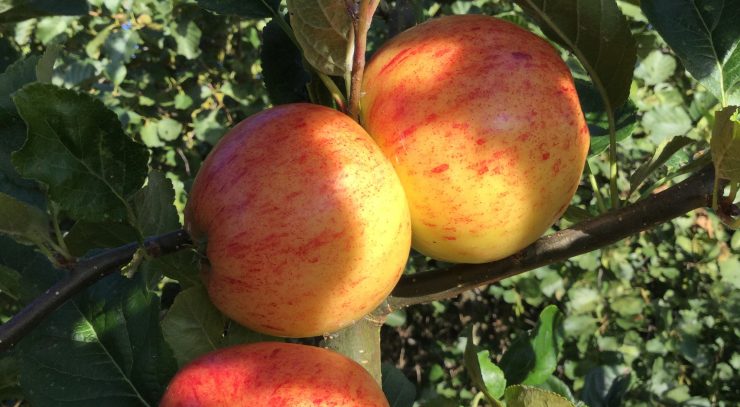[by Sarah and Niels Viggo] An apple is a gift, generously given by the tree, even wrapped in colors and patterns where you can almost directly read the message “I love you, please thrive and be happy”. But some apple trees are better at getting that message across than others, and some find new fresh juicy variations of it. Of course humans have chosen specific sorts to cultivate, playing it safe but losing some of the fun.
Niels: I live on the edge of the natural preserve of Mols, a more or less wild hilly area with thousands of self-sown apple trees. Every self-sown tree is a unique biological individual and produces a unique sort of apples, in most cases very inferior to cultivated sorts – because of course only the very best are chosen for cultivation. My kids and I used to have this competition every fall, of who could find the worst or weirdest apple. But in one case of a thousand the miracle can happen: a new apple more tasty and beautiful than any other you know. This is the Mols apple – named by us for the hills where it emerged. Juicy, sweet, aromatic – and with a characteristic play of orange and red stripes.
The Mols Apple mother tree grows in sandy soil, on a slope surrounded by thorny shrub, nettles and wild roses, obviously having a hard time surviving – but still giving hundreds of beautiful apples every October. Apart from my sons and me, I think very few humans have ever tasted them. But then there are other animals in the hills to make happy, of course.
We made a project out of propagating this special kind by learning the art of grafting – that is, basically, tree surgery where you transplant a few buds from the top of one tree on to the root of another. With sharp knives, care and good sealing wax, it is possible even for amateurs like us to have a pretty high success rate – about 80% of our new trees take on.



Our first generation of cloned trees are now 5 years old. We already knew the apples would be great, but in addition it turned out that the tree is healthy, fast-growing and generous. In 2016 and 2017 we have made 25 clones on “Great Grafting Day” – a familiy-and-friends event in February – and plan to go on. The idea is that this tree will always be a gift, never sold.
Last fall my friend Sarah joined the branching project of roots, grafts, care and fun and helped it mature into a philosophical project, by going around with me and planting trees – and at the same time making interviews with the new tree owners (or better, caretakers) about life, soil, place, taste, landscapes, futures, love and related issues. At this point we have only made the first four Apple Tree Dialogues and scheduled another 4-8, but we already got so much great “apple dialogue” taped that I can see this will be a great book if we can manage this wildly brancing project. We have already learned that apples and trees are strong reagents – they connect very actively with bodies, stories, landscapes and friendships, in many layers and directions.
Sarah: For Niels this ‘apples dialogue’ project has been slow growing, in home soil, surrounded by familiar roots. In contrast, I was grafted on a branch a little out of the blue, or rather, as always, out of the spinning of wheels of good fortune.
In October 2016 I was visiting the Interacting Minds Centre at Aarhus University (from the USA) for the Collaborative Minds Symposium, with a bunch of very nice and interactive philosophers, psychologists, neuroscientists – people talking and thinking together about people talking and thinking together – so already in a mood for the interactive, the recursive, the reflexive and the contemplative. Niels was there and we talked about the trees. When he mentioned the diverse and fascinating list of friends who had agreed to take a tree in their care, I thought about the book “Trois amis en quete de sagesse”, where a monk (Matthieu Ricard, a psychiatrist (Christophe Andre) and a philosopher (Alexandre Jardin) get together and talk about life, then make a (good) book out of it.



As we wondered whether interviewing the new caretakers and recording these could give rise to interesting material, it all came together. So we found ourselves the following Sunday road tripping around Denmark with young Mols apple trees in the back. Our four stops were different and wonderful. While our old-and-new friends picked the soil and sun for those promising roots, we listened and talked about growth, time, maturation, loss, and death. And then obviously life, and love. We spoke of planting as an act of faith, in times of turbulence. Of apple trees as being cared for and caring back, shaping and being shaped.
And like after a good apple – we were left with a joyful heart and clean palate, ready for more.
Next: Apple dialogues continued, with wonderful people in magical places in France, early summer of 2017, read it all here.
